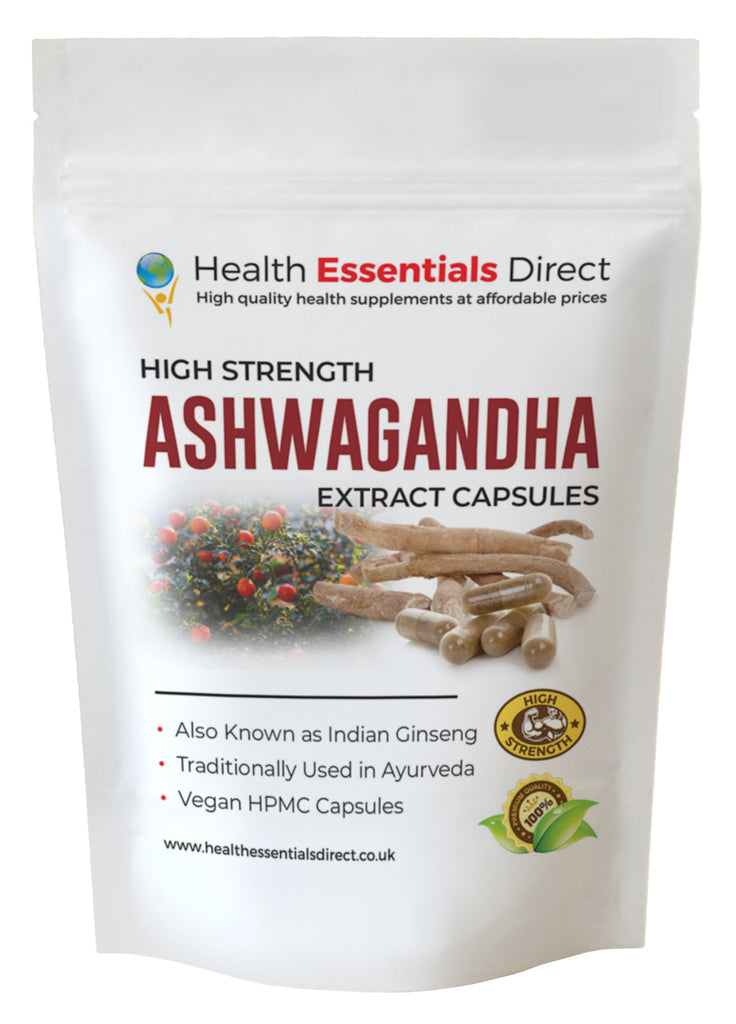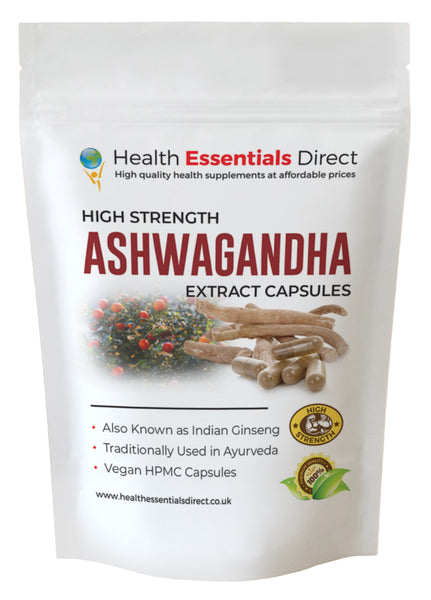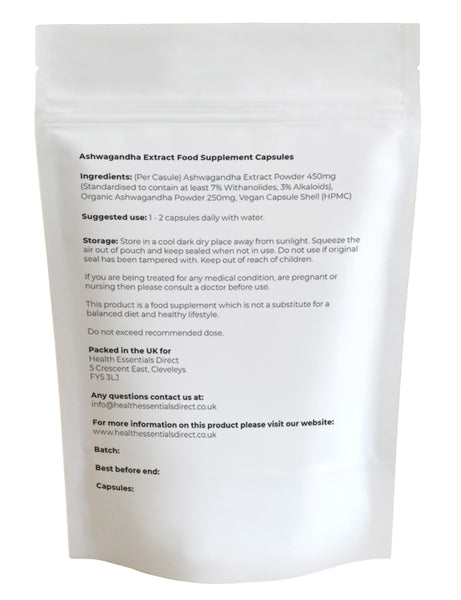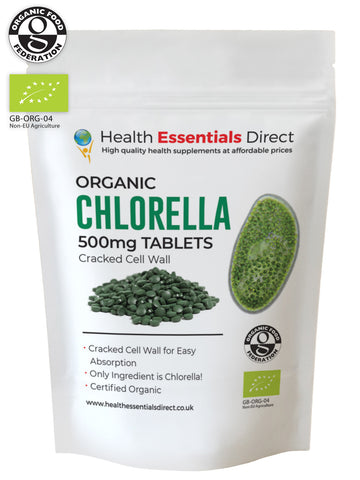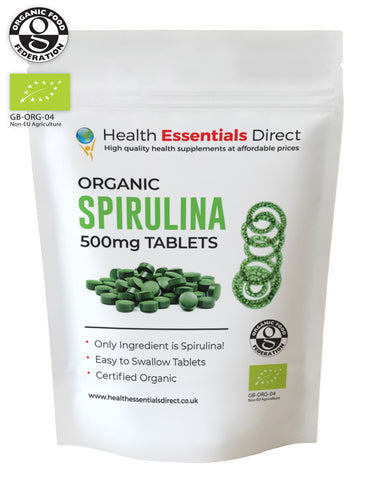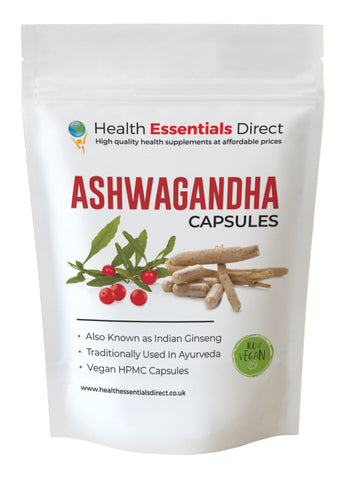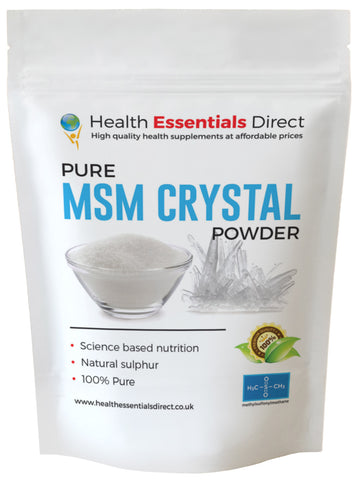Ashwagandha Extract Capsules - Ultra Strength 31mg Withanolides (Indian Ginseng)
4Ashwagandha Extract Capsules - Ultra Strength 31mg Withanolides
-
We Use Extract and Whole Root - Best of Both
-
High Strength Extract
-
Nothing Else Added, No Fillers or Binders
Each capsule contains:
Ashwagandha Extract Powder 450mg (Standardised to contain at least 7% Withanolides, 3% Alkaloids)
Organic Ashwagandha Powder 250mg
Equivalent of a huge 6750mg of Ashwagandha and 31mg of Withanolides per capsule! Unique blend of both extract and whole root powder to deliver the full benefits of Ashwagandha!!
We have listened to our customers who some say that our Ashwagandha extract is more effective for them while others say they prefer the organic Ashwagandha root powder, so why not have both in 1 capsule and reap the full benefits of Ashwagandha.
We manufacture our capsules on our own machines, we do not use any fillers or flowing agents in these capsules, they are 100% CLEAN and SAFE and suitable for vegans.
About Ahswagandha Extract
The ashwagandha plant (Withania somnifera) is a tiny evergreen shrub that is native to India, the Middle East, and Northern Africa. Some of the popular terms used to refer to the plant in different parts of the world include Indian winter cherry and Indian ginseng. Ashwagandha derives its name from the combination of two Sanskrit words, ‘Ashwa’ which refers to a horse and, ‘gandha’ which means smells like. This name came about because of the strong horse-like odor the roots of the Ashwagandha plant emit. Some additional names that were used to refer to the plant in different regions were Bahman in Persia and Arabia, ba-dzi-ghanda in Tibet, aasogandha in Nepal, Aswagandha in Japan, and kutilad in Putsu. The roots of ashwagandha are dried through natural means and ground into powder. The powder is often then put through a extraction process to produce a extract that have a higher concentration of the bioactive compounds.
Ashwagandha belongs to the species Somnifera and genus Withania. Somnifera is a Latin word that means “brings about sleep”. It is also grouped in the family Solanaceae. Solanaceae is commonly known as the nightshade family. This family has some common vegetables such as tomatoes, peppers, eggplants, and potatoes. This explains why the Ashwagandha plant looks almost similar to the other plants in this family. The term ginseng is always used when describing Ashwagandha when in the real sense, Ashwagandha has no relation to the family Ginseng. It is because Ashwagandha had the same applications in India as Ginseng had in China and Korea.
The Ashwagandha shrub grows to a height of approximately 1.25m in height. It has light-green ovate leaves which are averagely 4 inches long. The flowers which are shaped like a star are yellow to green and produce orange to red berries with numerous yellow seeds. The roots are fleshy, tapered, and light brown. Both the leaves and berries are harvested and processed into different usable forms. However, the roots have the highest composition of bioactive components. Ashwagandha is cultivated at altitudes of between 600-1200m. Semi-tropical regions form the perfect environment for the growth of this plant. They do fairly well in light sandy soils with a pH of 7.5-8.0. The soil should be able to drain properly. Rainfall of between 500-750 mm is sufficient for its growth. Ashwagandha requires an elongated period of drought when it is growing. Rains are only required later on to help develop the roots extensively. Temperatures should range from 20-40°C.
The vast use of Ashwagandha roots can be dated back to 6000 B.C. It was acknowledged by the ancient Indian civilization as a very potent herb. It formed one of the very essential elements in Ayurveda. It is believed that one of the most respected Hindu sages, Punarvasu Atreya recommended Ashwagandha to the King whenever he felt he was low on energy. Several of his teachings formed the pillar stone of ancient sacred Indian texts Charaka and Sushruta Samhitas that dates back to 4000 years ago. Some myths claim that the famous Alexander the Great and his men used Ashwagandha when preparing wine to add energy and bring about calmness before a battle. Another Legend states that Apollo, one of the Greek deities, came across this herb and gifted it to his son Asclepius, the god of medicine in ancient Greek mythology.
- Please note it is against MHRA guidelines for us to talk about any potential health benefits for this supplement however a quick google search on the potential benefits and you may be surprised.
How to use: We suggest taking 1 - 2 capsules daily with water.
Share this Product
feedback
great product, i`m very satisfied
Ashwagandha capsules
FANTASTIC..EASY SERVICE..GREAT PRODUCT...GOOD PRICE
Super
Prodotto di alta qualità ottimo servizio

